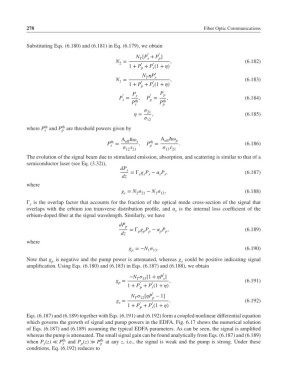Page 297 - Fiber Optic Communications Fund
P. 297
278 Fiber Optic Communications
Substituting Eqs. (6.180) and (6.181) in Eq. (6.179), we obtain
′ ′
N [P + P ]
s
p
T
N = , (6.182)
2 ′ ′
1 + P + P (1 + )
p
s
N P ′ s
T
N = ′ ′ , (6.183)
1
1 + P + P (1 + )
p s
P P
′ s ′ p
P = , P = , (6.184)
s th p th
P s P p
21
= , (6.185)
12
th
th
where P and P are threshold powers given by
s p
A ℏ s th A ℏ p
eff
eff
th
P = , P = . (6.186)
s p
12 21 13 21
The evolution of the signal beam due to stimulated emission, absorption, and scattering is similar to that of a
semiconductor laser (see Eq. (3.32)),
dP s
=Γ g P − P , (6.187)
s s s
s s
dz
where
g = N − N , (6.188)
2 21
1 12
s
Γ is the overlap factor that accounts for the fraction of the optical mode cross-section of the signal that
s
overlaps with the erbium ion transverse distribution profile, and is the internal loss coefficient of the
s
erbium-doped fiber at the signal wavelength. Similarly, we have
dP
p
=Γ g P − P , (6.189)
p p
p p p
dz
where
g =−N . (6.190)
1 13
p
Note that g is negative and the pump power is attenuated, whereas g could be positive indicating signal
p
s
amplification. Using Eqs. (6.180) and (6.183) in Eqs. (6.187) and (6.188), we obtain
′
−N [1 + P ]
s
T 13
g = , (6.191)
p ′ ′
1 + P + P (1 + )
s
P
′
N [P − 1]
T 12
p
g = ′ ′ . (6.192)
s
1 + P + P (1 + )
P s
Eqs. (6.187) and (6.189) together with Eqs. (6.191) and (6.192) form a coupled nonlinear differential equation
which governs the growth of signal and pump powers in the EDFA. Fig. 6.17 shows the numerical solution
of Eqs. (6.187) and (6.189) assuming the typical EDFA parameters. As can be seen, the signal is amplified
whereas the pump is attenuated. The small signal gain can be found analytically from Eqs. (6.187) and (6.189)
th
th
when P (z) ≪ P and P (z) ≫ P at any z, i.e., the signal is weak and the pump is strong. Under these
s s p p
conditions, Eq. (6.192) reduces to

